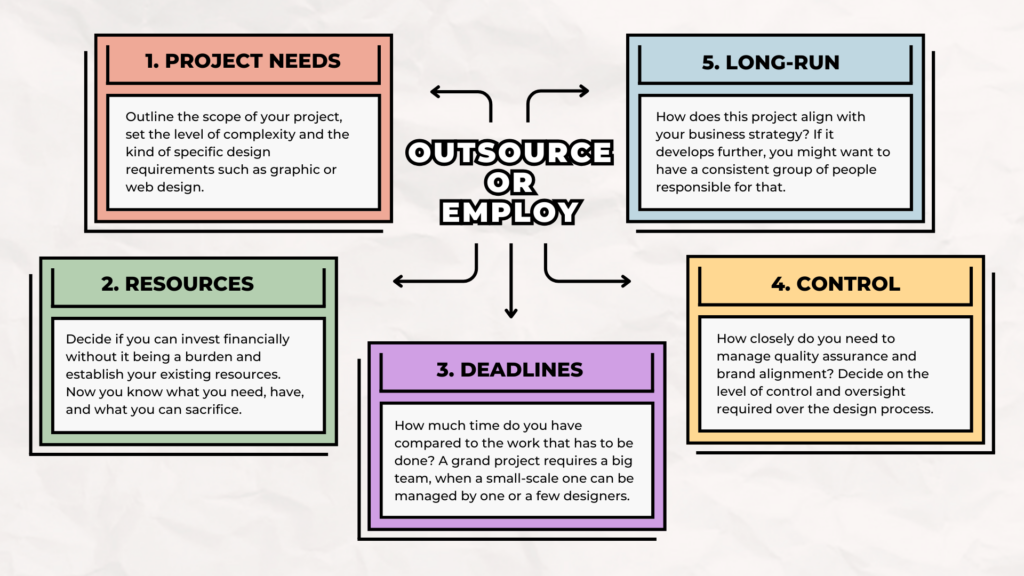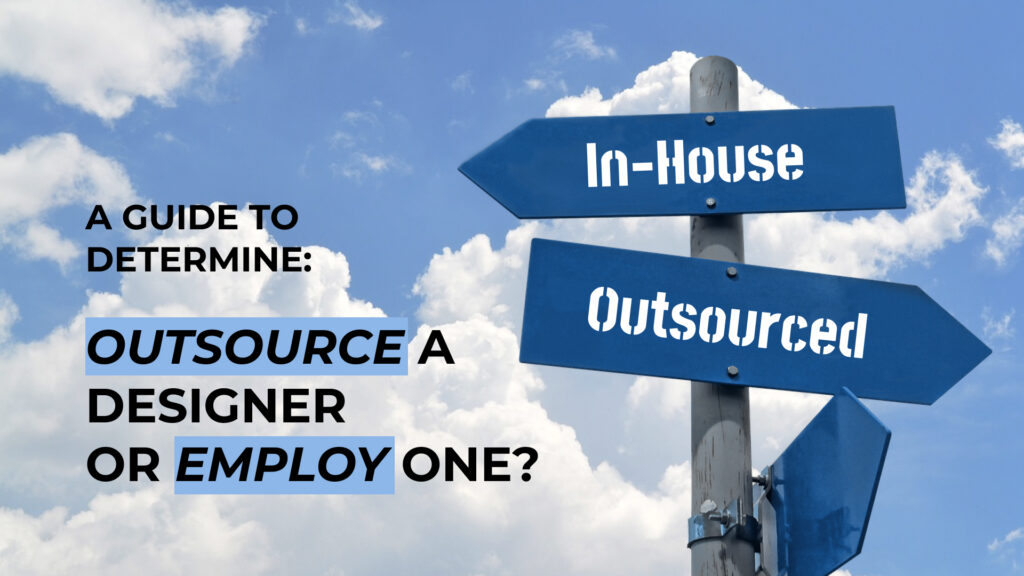When organizing design projects, you may find yourself at a crossroads: should you hire an in-house designer team or just rely on an outsourced one? These are two very different approaches to work that have various drawbacks and benefits. The core difference lies in such factors as budget, project complexity, and, of course, deadlines. While making this crucial choice, you may as well consider the level of control you want to have over the whole thing. Are you okay with it being a third party, or do you trust your actual employees more? Taking every little aspect into account, you will surely harvest the finest fruit in the end. This article is set on helping you understand all the intricacies of the in-house vs. outsourcing question.
Table of contents:
Understanding Your Design Needs
Let’s start with understanding and defining your special needs. This is truly one of the most important steps, as it provides a clear view of your business’s potential design requirements. By outlining your ideas, you can easily determine which approach will suit your project’s needs best.
For instance, if you’re in for graphic design, it often requires a strong understanding of the brand strategy, style guides, and aesthetics. Logos, advertisements, and social media graphics shall all coincide and follow suit so that the overall picture remains consistent and sustainable. Keeping your image intact requires maintaining a unified visual strategy and ensuring that every piece of content aligns with the established brand guidelines. This cohesion can be challenging to achieve if you outsource graphic design because such a team may not be as deeply integrated into your company culture and brand philosophy as an in-house one.
Provided you aim mostly at web design, the number one requirement is the creation of a coherent and functional layout. At this point, what matters is how easy and enjoyable your website is to use. A well-designed website should be intuitive, helping users navigate smoothly while conveying your brand’s message. While having your own web design team gives you more control over the matter, a decision to outsource web design can provide you with access to specialized skills and the latest trends in the technology sphere that your in-house team might not have. Here, graphic design outsourcing does the trick.

A top-notch UI/UX design ensures that your product is not only visually appealing but also highly functional and user-friendly. Your own UI or UX design team could collaborate with a development team and keep your website up-to-date, refining the experience based on user feedback and testing. On the flip side, outsourcing UI/UX designers can bring fresh perspectives and cutting-edge techniques to your creative workflow if you’re not in for the long run. External professionals can bring the latest industry standards to your product, enhancing its usability and appeal.
Whether you decide to outsource or hire in-house designers, the key is to align your choice with your project’s specific needs, budget, and long- or short-term goals. Each opinion has its unique set of benefits and downsides, knowing which you’ll be able to make the grade in any situation. And when it comes to ensuring your projects meet the highest standards, having a reliable design approval process and a creative project management tool, like the one provided by Approval Studio, can make a significant difference!
Pros and Cons of Outsourcing
What is outsourcing in design? It has become a popular choice among many businesses because it is cheaper and provides a huge pool of talented specialists. However, nothing is perfect in this world, right? So, here’s outsourcing in a nutshell:
Pros:
- Access to specialized expertise.
As already mentioned, outsourcing is a bottomless treasure trove where you can find the right person for your most intricate whim. In a 2024 UK survey, nearly half of 3,000 respondents claimed that the main reason for outsourcing was the lack of in-house skills.
- Cost-effectiveness for short-term projects.
If you’re not looking for anything grand, where’s the point in a full-time designer team management? In such a case, you’ll probably profit more by finding an external professional who can do the job as a one-off deal.
- Scalability and flexibility.
With outsourcing, there’s no need to settle for a defined team of certain employees. Depending on the aspects of your projects, you can always hire this or that suitable specialist and manage the number of people engaged in the process without a hitch.

Cons:
- Communication challenges.
While outsourcing allows you to find professionals from all over the world, it also has a slight drawback to it. Working with external teams can lead to miscommunication or misunderstanding due to differences in time zones, language barriers, or, basically, lack of good ol’ face-to-face interaction.
- Potential quality control issues.
Consistency of your brand image can go a bit off-track when you work with external specialists. With outsourcing, especially for short-term engagements, designers might not have the opportunity to fully integrate into your business’s vision and values, impacting the quality and coherence of their work. Furthermore, an outsourced design team can work on a couple of different projects simultaneously, leading to loss of focus and missed deadlines.
- Lack of direct control over the design process.
With no direct supervision, it’s way harder to keep track of the project’s progress. If there’s no real-time feedback, it’ll take much more time to discuss even quick adjustments. You’ll have to rely on an online proofing tool rather than a face-to-face one. As issues arise, you’ll have to wait a while before the changes are implemented. But do you really have that ‘a while’?
Pros and Cons of In-house Hiring
What about the in-house approach, then? In simple terms, the drawbacks of outsourcing are the strong sides of in-house and vice versa.
Pros:
- Direct control and management of the design process.
When you have your own design team, you get to call the shots. Unlike outsourcing, this approach gives you immediate access to your employees, allowing real-time feedback and quick adjustments as the issue arises.
- Better integration with company culture and long-term vision.
In-house designers live and breathe your brand. These people are part of your company, which means they are fully inserted into the things you have going on. Your values, long-term goals, and visions are understood and followed. This fosters a deep connection to the company’s mission and provides creative collaboration and more cohesive design work.
- Higher level of commitment and loyalty from team members.
Your interests and goals align when you’re in the same boat. In-house designers will be more invested in your company’s success. This commitment can lead to higher quality outputs and a more loyal workforce.

Cons:
- Higher costs associated with salaries, benefits, and infrastructure.
However, having a full-time employee, especially a team, involves significant expenses such as salaries, office space, equipment, software, and other little things that add up quite quickly. For a small business, this is a real financial burden.
- Limited access to specialized skills.
Truth be told, finding a consistently perfect design team is a real headscratcher of a challenge. With outsourcing, you can manage a team like an endless deck of cards, choosing the ones most suitable for each project. Meanwhile, with an in-house team, you’ve got to work with who you already have. It doesn’t mean it’s bad, though. It just restricts your pool of choice, that is.
- Potential resource constraints for fluctuating project demands.
Continuing the matter of choice restriction, there might be projects too small or too big for a team. Basically, if the project is grand, your in-house team might be stretched thin, leading to burnout and a dip in quality. Similarly, small-scale projects make you pay for resources that aren’t being fully utilized. In simple words, this can lead to whether overworked designers or idle resources.
Case Studies and Examples
Slack, one of the most renowned names in workplace communication, answers the question of how can outsourcing lead to increased revenue and pay off with flying colors.
In 2013, they hired a Canadian company, MetaLab, which resulted in the creation of their logo, marketing site, and the web and mobile apps. This move gave Slack a unique brand identity that set it apart from competitors. They moved to $2.8 billion by 2015, and nowadays, the company’s value equals more than $26 billion, with 200k+ paid customers.

Slack’s inspiring story shows how a nearshore outsourcing decision allowed them to access top-tier design talent without the overhead costs of hiring full-time employees. With a strategic approach, outsourced design can be a game-changer tool for startups looking to establish and grow their brand effectively.
But hey, can an in-house design team hold a candle to an outsourced one? Well, haven’t you heard about Apple? Their policy of working with an in-house design team has shaped their brand identity and resulted in iconic products easily recognised around the globe.
With its sleek aesthetics and intuitive interfaces, Apple’s focus on design excellence is what makes its product stand out. Every curve, every icon, and every interaction is crafted with care, which makes using their products a joy. Having a full-time design team allows the company to ensure that its hardware and software work perfectly together, promoting a smooth user experience.

In a sea of tech products, Apple’s unique design helps them stand out, attracting customers who want something that’s both functional and beautiful. Because Apple products look and feel so premium, people are willing to pay more for them. This keeps Apple’s profit margins high. This strategy not only keeps its customers loyal but also keeps Apple ahead in the tech game, making it one of the most profitable companies in the world.
Conclusion
Summing up, it’s clear that there’s no better or worse approach: the choice depends solely on your interests. It all starts with understanding your specific needs and aligning your choice with your business goals.
While outsourcing gives you access to a wide specialist pool, saves costs, and offers scalability, in-house hiring means more direct control, better alignment with your company, and greater team loyalty.
Take a look at Slack, for example. They outsourced their app design to a Canadian company, which gave them a unique brand identity and helped them grow rapidly. On the other hand, Apple sticks to an in-house design team, ensuring their products look and feel top-notch, which keeps their customers coming back and their profits soaring.
Ultimately, the best choice depends on your project’s scope, timeline, and long-term strategic objectives. By carefully evaluating these factors, you can make an informed decision that aligns with your business’s growth trajectory and ensures the quality and success of your design initiatives. To do so, you can use this 5-step checklist on how to decide whether you need to outsource design or hire full-time:

With the help of this checklist, you can ease your decision-making process and outline your action plan. Consider each step carefully and prepare to harvest your success’s fruits. Bon voyage!

 TEAM SOLUTIONS
TEAM SOLUTIONS WORKFLOW SOLUTIONS
WORKFLOW SOLUTIONS



 REVIEW TOOL
REVIEW TOOL PROJECT MANAGEMENT
PROJECT MANAGEMENT TOOLS & INTEGRATIONS
TOOLS & INTEGRATIONS
 CLIENT INTERVIEWS
CLIENT INTERVIEWS









